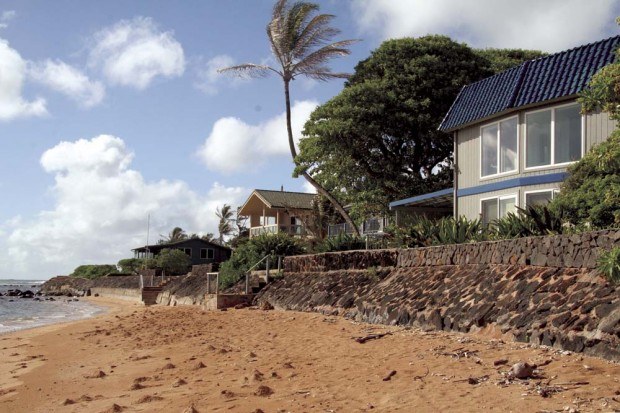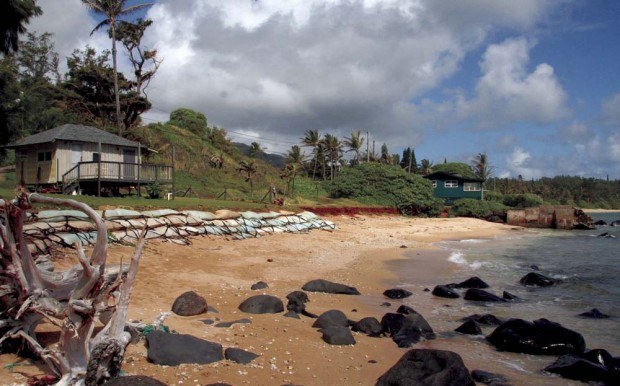Ocean eating Anahola properties
ANAHOLA — Beachfront properties face constant threats from nature, such as pounding surf, surging tides and an occasional tsunami or hurricane. Sometimes, however, human efforts to protect their coastal homes against these destructive forces can have the opposite effect.
Anahola resident Wayne Medeiros said that after one of his neighbors, Albert Morgan, built a seawall, erosion caused by ocean currents accelerated and ate up about 120 feet of his family’s property on ‘Aliomanu Road.
Work performed by the county to protect the road near Medeiros’ home also contributed to erosion, he said, and his family has since spent tens of thousands of dollars in mitigation efforts.
“We lost about half the property so far,” Medeiros said.
His next-door neighbor, the Lizamas, were even worse off. They lost their home and the majority of their property due to erosion. Only a narrow stretch of grass remains on their property.
The Kaua‘i Planning Commission in 1981 gave the Morgans and other homeowners a permit to build a loose-rock revetment, which is a sloped rockwall allowing the wash of the waves to be absorbed in open cracks of stacked boulders rather than deflected, a county spokesperson said.
“Instead, what he built was a vertical seawall that’s cemented in place,” Medeiros said. “And that was not authorized.”
The seawall begins at Morgan’s property and continues north, hardening the shoreline in front of six homes altogether.
On July 24, 1997, the commission issued its Findings of Fact and Conclusions of Law Decision and Order that the seawall was not built according to the plan that had been approved, and that the landowners had not complied with the terms of the Special Management Area Use Permit, leading to significant erosion of the shoreline.
Rather than revoke the 1981 permit, the commission issued a permit modification to: 1.) require a one-time sand replenishment program to affected neighbors; 2.) alter the seawall’s south-flanking portion; and 3.) repair the seawall and area mauka to it, according to county officials.
A lengthy legal battle ensued.
Landowners appealed to the 5th Circuit Court, which on June 30, 1999, under the gavel of Judge Clifford Nakea, reversed the commission’s decision, saying the commission did not have authority to modify the SMA permit nor should have ordered injunctive relief.
The county, in turn, appealed to the Hawai‘i Supreme Court, which on March 24, 2004, upheld the commission’s ruling to require the repairs to the seawall and the alteration of the southern portion, but said the commission did not have authority to require the sand replenishment program.
On Sept. 3, 2009, the county Planning Department issued letters to all landowners to prepare surveys of the seawall documenting the location of the existing seawall, location of all property lines and existing structures on the referenced property, county officials said. The department then requested each landowner to provide a preliminary plan for repairs and modifications to the existing seawall, including construction design of the south-flanking seawall.
One owner has submitted a draft plan to repair the southern portion of the wall, according to county officials, who said they are checking to see if any others have been filed.
The Morgans could not be reached for comment by press time.
To this day, the seawall has not been redesigned. Properties south of the Lizamas’ — including Medeiros’ property — have plastic sandbags stacked at the shoreline as a protection against the ocean.
“We paid a private contractor almost $100,000 to put sandbags there,” Medeiros said.
County project
Residents are blaming a county project for adding to the problem.
Just before a soft shoulder on ‘Aliomanu Road leading to Medeiros’ home, over 100 feet of the road has been damaged by the ocean, allowing room for just one car at a time.
Medeiros said that in December 2002, a day after the late Mayor Bryan Baptiste took office, county workers went into the ocean at low tide and using heavy equipment pulled out large boulders and placed them against the road.
A county spokesperson said July 8 that county officials made “exhaustive inquiries in Public Works and no one can recall moving boulders in 2002.”
Deputy County Engineer Lyle Tabata said the county in 1996 used ocean boulders on road repairs. But the state Department of Land and Natural Resources found out, he said, and made the county return the boulders to as close as possible to their original location.
“The boulders were not used for a seawall as originally asked,” Tabata said.
Medeiros stood by his story, and backed his account with pictures of county equipment sitting on the side of ‘Aliomanu Road at the time.
County Planning Inspector Les Milnes shared another version. He said the rocks originally belonged on the side of the road, and were moved onto the reef by the surf, especially during Hurricane Iniki in 1992. He also had aerial pictures taken in 1992, in which rocks could be seen against the road.
However, the family of Medeiros’ wife has owned the property for 66 years, and he swears the original location of the boulders was always on the reef. He too says he has seen them there with his own eyes.
“I’m 56 years old,” Medeiros said. “I’ve been there in my teens, and I told them those boulders were always in the ocean.”
Anahola resident Hosea Lovell was quoted in an article published Jan. 15, 2003, in The Garden Island, in which he complains about the county taking boulders from the reef, and warns of further erosion if they weren’t returned.
“We are going to see more erosion,” Lovell said, adding that the removal of the rocks resulted in the loss of various species of limu which attracted fish to the reef. “The fish will not come back if the rocks aren’t put back, because the rocks is where the limu is.”
Lovell, who was 6 years old when he first began fishing there with his father, died at age 84 on July 23, 2010.
If rocks were placed against the road, they are now covered by hundreds of burlap bags, put there by the county to protect what’s remaining of the road.
Tabata said the sandbags are a temporary measure until the county acquires several permits to allow reconstruction of 300 feet of the road and a 500-foot revetment wall to protect the road from future erosion.
The burlap sandbags are filled with sand picked up from the river mouth — for which Tabata says the county has a permit — just south of that area. The bags last about a year, and the county in June replaced some of them.
Boulder removal
Robin Rogers, who has lived in the area for about 15 years, said in December 2002 he saw county workers pulling the rocks from the ocean and placing them against the road.
“I didn’t think too much about it,” he said. But soon after the rocks were removed the beach erosion accelerated, he said, taking much of the sand away.
“We live on the road,” Frank Ursomarso said. “The county did use boulders from the ocean and moved them to the road side. When the boulders were moved the erosion increased.”
He said the boulders are under the burlap sandbags.
Rogers said the pounding surf was eroding the road away, and something needed to be done to protect it, but by taking the rocks off the reef it changed the way the current flows.
“Same thing happened when they put up the seawall (up the road),” Rogers said. “Everything on the other side started caving in and giving way.”
Mayor’s offer
Trying to solve the problem, Medeiros said his family and the Lizamas had a meeting with Baptiste.
“He felt kinda responsible, because he knew what the county did,” Medeiros said. “He had offered to provide sand that the county had, so we could use it to either refill sandbags or replenish the beach.”
Medeiros’ wife, Manu Medeiros, said Kaua‘i attorney Jonathan Chun — representing Josh Simpson, another homeowner affected by the erosion — met with Baptiste in June 2003. The meeting, she said, was also attended by Milnes, then-Planning Director Ian Costa and Sam Lemmo from DLNR.
Manu Medeiros said she has the minutes of the meeting, but was unable to locate them.
Baptiste died in 2008, and Mayor Bernard Carvalho Jr. took office at the end of that year.
County spokeswoman Beth Tokioka said Baptiste’s calendar books were given to his family at their request following his death. But she said she found emails that show that on Dec. 2, 2004, Baptiste had a meeting with the families — she wasn’t for sure which ones, but said she assumed the Lizamas and the Lemkes — and the mayor later asked Costa to meet with Wayne Medeiros to discuss storage and stockpiling of sand.
“There is no documentation in our file regarding subsequent discussions with Ian (Costa),” Tokioka said. “Ian (Costa) does not recall any ‘promises’ made by Mayor Baptiste to Wayne or his family relating gifting of sand from the county.”
She said if Baptiste made a “verbal commitment in a meeting that was never documented” she would have no way of following up on that.
“I’ve checked with individuals in Public Works and Planning (Department) who would have been likely to follow up on such an agreement and no one recalls this,” Tokioka said.
Manu Medeiros found a letter from Wayne Medeiros to DLNR, dated Dec. 7, 2004, in which he asks then-Chair Peter Young for permission to remove 1,000 cubic yards of sand from Anahola River to erect a sandbag barrier in front of his neighbor’s home.
“The actual removal of sand would be done by the county of Kaua‘i,” he said in the letter. “The ‘sea bags’ are due to arrive anytime now and the county of Kaua‘i is just waiting for the permits before removing any sand.”
Tokioka said an email dated Dec. 15, 2004, indicates that Wayne Medeiros called Baptiste and left a message that he had spoken with Lemmo, who had given approval to remove sand from the Anahola river mouth as long as the crew didn’t touch the water.
Wayne Medeiros said he tried to follow up with Carvalho’s administration after Baptiste’s death.
Manu Medeiros said attorney Glen Hale sent a letter to Carvalho on Nov. 16, 2009, requesting the county to honor Baptiste’s commitment to provide the sand. On Jan. 20, 2010, Hale received an email from Lori Kelekoma, a member of Carvalho’s staff, stating that she would check on it and get back to Hale, according to Manu Medeiros.
“Neither she nor Mayor Carvalho ever did,” she said. Her husband was also upset at Carvalho’s apparent disregard.
Tokioka said she would not dispute the letter was sent to the mayor’s office.
“He very well could have and it’s possible that we failed to get back with him and schedule the meeting,” she said. “I’m sure this was an oversight and not lack of concern on the part of the mayor.”
Wayne Medeiros has had meetings throughout 2009 with the county attorney regarding legal issues surrounding the seawall, Tokioka said.
“So it’s not as if the county has been wholly unresponsive to his inquiries on this matter.”
Tabata said the project to build a revetment wall against the road is Carvalho’s follow-through.
But Medeiros said the revetment the county is planning to build will go the opposite direction, toward the river mouth, where there’s “absolutely no danger” of erosion to the road.



